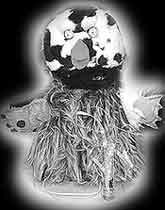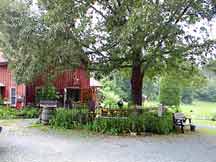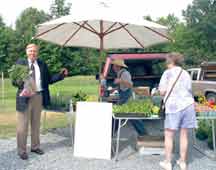|
|
At University of Maryland, Invention is For Kids

Kids at University of Maryland’s Human-Computer Interaction Lab worked with adult researchers to make this original prototype for PETS - Personal Electronic Teller of Stories - which has already been licensed and may go into production this year.
Squirreled away in the maze of brick walls and hallowed halls at University of Maryland’s College Park campus is a small laboratory. Within sit the tools you’d expect of something called the Human-Computer Interaction Lab: soldering irons, computers, robot parts, various electronic bits …
… and construction paper and crayons.
Tools left over from the days of open enrollment? Not quite. Though decidedly low-tech, these and other basic art supplies are the materials with which eight kids, ages seven to 12, are shaping the technological future of the young set.
“We see them as short graduate students,” says Allison Druin, leader of the lab’s inter-generational research team. The Kids Team is her brainchild, conceived four years ago to give kids a say on the technology being created for them. “Typically,” she says, “children’s voices are not heard.”
To be heard, the kids supply abstract creativity in the form of brainstorming or non-functional models of inventions they’d like to see. Where it’s technologically possible, their 12 adult counterparts — an interdisciplinary crew of artists, programmers, roboticists, etc. - forge the working versions. Sometimes the kids help on simpler components.
Sponsor companies come to the team looking for brainstormed ideas or feedback on prototype toys and games. Grants from government agencies, including the National Science Foundation and the European Union, help keep the kids in business with public projects. While much of their tinkering is reactive, the crew also dreams up its own ideas and pushes proposals.
“They have room for crazy people to submit crazy ideas,” says Druin of the lab’s sponsors. The crazy thinking may be catching. The kid-based research team now partners with groups in Britain, Sweden and France.
Seven ongoing projects are in the works. In one, the kids are helping develop technology for three- to six-year-olds to use in classrooms of the future. In another, the team created a downloadable animal game for Neurosmith’s Music Blocks. The Story Rooms project proved a surprising lesson for researchers in 21st-century kids’ affinity for the simpler things: Kids are designing kits for creating interactive storytelling with found or created objects. On the other hand, the kids’ cyber-puppet reading pals might soon appear at a store near you.
Pets - Personal Electronic Teller of Stories - begun in 1998, has already been licensed to a company and may go into production within the next year. Kids can build the ’bot into any animal they want with robotic animal parts (dog paws, wings, horns, etc.) and use it to tell their own stories. By using the accompanying software, kids can program in emotions and behaviors; wireless remote wristbands and hats will let them control the pets as a puppet. It’s a far cry from what grown-up researchers thought kids would want - a taskmaster robot for doing homework and cleaning bedrooms.
“We’re the only team that designs things for kids that really uses kids in the design process,” says Kids Team player Thomas Schwenn, age 12. “It’s a pretty new field.” Schwenn, who just finished eighth grade this year after skipping seventh, has been with the team since its inception. “The best part about it is that we’re doing something new and we get to play with interesting technology,” he says.
Kids need not be three-foot-something savants to sign on; in fact, most aren’t star students. “Some of our kids are the quietest in class; all they did was draw,” says Druin. There are even those who’d never touched a computer before signing on. Academics aren’t everything here; the lab is most concerned that the kids are creative team players who can communicate their ideas.
The team gets about two new faces each year; so far, 14 kids have gone through. Most stay for about two years, and there’s a waiting list to get in. But it’s a sweet gig if you can get it: The kids can stay with the lab as long as they want, enjoying guaranteed snack breaks plus “technology gifts” like Nintendos or digital cameras at year’s end.
The Kids Team returns to the lab for the first two weeks of August, putting in six hours each day during an intensive run to kick off new projects and train new arrivals. During the school year, they’ll put in time after school on Tuesdays and Thursdays, alternating between projects.
- Mark Burns
Death by Algae: A Bay Mystery
It wasn’t toxic pfisteria, that scourge that moved up the chain from algae, infecting fish, fishermen and scientists back in 1997. Still, Herring Bay was littered with dead fish and crabs.
“There were thousands of dead fish floating on the water and a lot of eels swimming on the surface, gasping for air,” said Suzanne Demas of Fairhaven, a biologist. That was June 30.
Over the following three or four days, the dead covered Fairhaven beaches. As well as “an enormous number of crabs and dead fish, clam worms and mud worms were deep on the beach,” Demas said.
Slowly, the dead drifted north toward Shady Side.
This time the killer was heat, which started a chain reaction that exhausted the oxygen in shallow Herring Bay, a semicircle that stretches from the Calvert County line to Deale.
“We found dissolved oxygen levels in the .18 milligram per liter area. The normal range is eight to 10 milligrams per liter. The dissolved oxygen was almost a thousand times lower than what it should be,” says Maryland Department of the Environment spokesman Rick McIntire.
Crabs, eels, fish and worms suffocated.
In the days leading up to the kill, the weather, you’ll remember, had stagnated. Intense sun for several days with little wind had turned on the growth switch in more places than your garden. In the water gardens of Bay shallows and creeks, it turned on the growth switch of a plankton life form called algae.
“All day they photosynthesize, which starts depleting oxygen in the water at night,” explains McIntire.
At the same time, hot weather increases the biological oxygen demand of all aquatic life. “Heat for them is just like climbing a mountain for us,” says McIntire. “The higher we climb, the more air we need.”
Oxygen disappears first in shallow waters and waters full of nitrogen pollution from septic systems, lawn chemicals or animal waste. Herring Bay fits both bills. On the Western Shore, smaller kills were also tracked on the Magothy River near Dobbins Island, the headwaters of the Severn River and Mill Creek just north of Greenberry Point.
The algae intensifying these episodes of thermal shock aren’t pfisteria or the toxic bluegreen algae or poisonous brown or mahogany tides you’ve likely been reading about. But they’re all kin, and they all like the same conditions. Nutrient enrichment - which swells as a byproduct of human colonies surrounding the Bay - sets algae into a growth frenzy. Summer supplies the heat and sun that cooks the stew. Under those conditions, pfisteria is always with us.
What turns the algae toxic, as it was in ’97, “we don’t fully understand,” says Maryland Department of Natural Resources spokesman Chuck Porcari.
- Sandra Martin
 In Calvert, It’s Not Grandpop’s Farm Anymore In Calvert, It’s Not Grandpop’s Farm Anymore
If you pronounce Calvert County as Culvert, then you’ve probably been around long enough to remember when there was nothing but farms and farmers. Back then you might have called them hayseeds; now they’re Calvert’s living history.
And if you’re a lately coming city-slicker, you likely don’t know a bull from a heifer.
“Chocolate milk comes from brown cows. That’s what kids think nowadays,” says Betty Knapp, of Loch Less Farm, a driving force in the Calvert County Agriculture Commission. “There are so many people coming into Calvert County that old neighbors and new hardly know each other.”
You’ll know a little more if you come along on Calvert County’s Fourth Annual Farm Tour.
“We change farms every year to have a variety of things to draw patrons of all ages,” says Calvert’s Department of Economic Development head, James Shepherd.
This July 15, a trio of Calvert’s surviving farms invite their neighbors in to see how old ways survive in these days. All of this year’s farms are located in central Calvert just off the southern corridor of Route 4. As in previous years, you’ll see farms that blend tradition with innovation.
Calvert Homestead is living proof that it’s never too late to take up farming. Robert and Barbara Burnett were maturing hippies when, in 1980, they went back to the land. He was handy at whatever he tried ; she wasn’t afraid to try anything. Together they restored the dilapidated historic Lyle Simmons house, planted gardens of flowers and herbs and lived off the land.
He took up making brooms the old-fashioned way, from straw he’d grown and cut; she found there wasn’t a flower that could resist her touch. Soon their homespun business was thriving. Who’d have thought so many people wanted artful, antiquey arrangements of dried flowers? Winning a space on the Shopping Channel, they sold orders for thousands of real tobacco sticks hung with little bouquets.
But Robbie, a Vietnam vet, died last year, a victim of Agent Orange. Now Barbara is discovering all over again that the land will sustain her. She’s reinventing her Homestead, beginning with planting a seven-circuit stone labyrinth to help searchers of all generations find their way.
Visit Calvert Homestead, 4555 Sixes Road in Prince Frederick, and you’ll tour their tree farm, ride a farm wagon, see a Native American exhibit and watch a blacksmith at work. On the side of innovation, you’ll take a meditative walk within the farm’s labyrinth.
For Linda Molesworth, Fresh Meadows is a dream come true. The veterinarian dreamed of a state-of-the-art full service hospital where horses could come to her instead of the other way around. On September 1, 2000, that dream became reality as she opened her 10,000 square foot barn with 16 rolling stalls, an office and an apartment.
On Molesworth’s 47-acre farm. horses receive acupuncture, chiropractic care, artificial insemination, dentistry and even stay for rehabilitation or to foal. Soon she’ll take her farm to another level by installing x-ray equipment.
Visit Fresh Meadows, at 2195 Hunting Creek Road in Huntingtown, for equestrian pleasures, including horse demonstrations, a parade of horse breeds and, naturally, a composting exhibit. For kiddies, there’s a petting zoo, hay rides, pony rides and a grain game.
Farming is part of Timmy Gott’s heritage. He works the 123-acre Riverview Farm, as did his father and grandfather before him. Part of Calvert’s dwindling premiere farmland, Riverview has moved into the 21st century, abandoning its long-time tradition of growing Maryland Type 32 tobacco. Now hay, soybeans, wheat oats and corn must pay the bills. Only time will tell if these changes are successful — or if Galen Gott will carry on the family tradition, becoming a fourth-generation farmer
Visit Riverview Farm, off Broomes Island Road at 8815 Mackall Road St. Leonard, and you’ll discover a primitive county farm with its display of antique tractors and an archaeological and hogshead tobacco exhibit. Wagon tours, pony rides, cloggers and Farmer for a Day Game complete its lineup.
At every farm, you’ll be lured by fruits, vegetables, baked goods, herbs, dried flowers, perennials and refreshments for sale.
1-5pm @ Riverview Farm, 8815 Mackall Rd., St. Leonard • Calvert Homestead, 4555 Sixes Rd., Prince Frederick - Fresh Meadows, 2195 Hunting Creek Rd., Huntingtown. Free; No pets: 410/535-4583 www.co.cal.md.us/cced
- Connie Darago
 Pols Crowd Veggies as Deale Farmers’ Market Opens Pols Crowd Veggies as Deale Farmers’ Market Opens
TEverybody came but the corn. Squash, potatoes and beans came. Red onions, flowers and herbs came. Breads and pies and brownies came. Even tomatoes came, though by their greenish complexion you could tell they’d been under the weather.
Those green tomatoes certainly would have better color by next week, farmer Bill Morris said. Corn would be coming, too.
To you they just might be vegetables and dough, but to Southern Anne Arundel County, they were stars.
“Fresh local produce was an overwhelming favorite in our poll [about how to improve the local quality of life at 2000’s South County Festival,” said Ann Wolfe, organizer for the Alliance for Rural Business.
Wolfe wasn’t kidding. When the Deale Farmers’ Market, hosted by the Cedar Grove Methodist Church, opened July 5, veggies and dough got a star-studded welcome.
Everybody but the governor turned out to greet them. Or so it seemed. Two hundred shoppers picked stalls empty before torrential rains closed the market early.
You couldn’t turn around without bumping into a politician. Maryland Department of Agriculture sent its top man, new secretary Hagner Mister, of Calvert County. Led by the president of the Maryland Senate, Mike Miller, the General Assembly sent a contingent four members strong. Cheering on the produce were delegates Dick D’Amato, Virginia Clagett and George Owings.
“It’s said that all politics is local,” quipped Delegate Owings. “All produce is local, too, and we should patronize local growers.”
On opening day, five experienced Southern Anne Arundel farm market hands plus a Calvert County baker filled the shopping bags of eager customers. The farmers: Market Master Bill Morris, Churchton; Gail and Eldridge Wilkerson, Tracys Landing; Raymond and Sonia Wood, Lothian; and Jean Grimes of Two Hollies Farm in Shady Side, the market’s organic grower. Bakers are Rev. David and Margaret Lewis of West River and Susan Berman of Bunnyhead’s Bakery, Breezy Point.
You can patronize the new market - the youngest of Anne Arundel County’s family of four markets supplying locally grown or produced goods - every Thursday through October, 4:00 to 7pm at Cedar Grove United Methodist Church, 5965 Deale-Churchton Road.
- SOM
Way Downstream ...
In Massachusetts, the EPA is pursuing cranberry growers for illegally filling wetlands to expand their bogs. One grower, Charles Johnson, is so indignant at such allegations that he videotapes investigators on his land and spent $150,000 on lawyers and consultants to fight them …
In Thailand, a woman who believes that a five-foot-long monitor lizard possesses the spirit of her dead son has won the first round of a custody battle, Reuters reported this week. After her 13-year-old son died in a motorcycle crash, the lizard took up residence in his bed and took a liking to yogurt and other of his favorite foods, she says. Authorities want the endangered lizard in a zoo, but are backing off just now …
Our Creature Feature comes from Richmond, where, suddenly and with brute force, a two-pound shad smashed through the window of a pickup last week at the East End Auto Sales lot. The mystery of the flying fish is yet to be unraveled with clarity. It’s true that car dealers have been known to make enemies by selling lemons. But it would have taken a mighty toss indeed from any passing vehicle to cause such damage. The best theory, as we see it, is that a bird high overhead - perhaps an eagle - let lunch slip from its talons. Dropped from 150 feet, the fish could have been traveling 70mph, a physics professor figured.
Copyright 2001
Bay Weekly
|